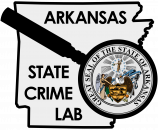Q & A’s About Bath Salts
| For questions, please contact: | |
| Felisia Lackey Forensic Chemistry Section Chief 501-683-6193 [email protected] | Cindy Moran Assistant Director 501-683-6190 [email protected] |
What are Bath Salts?
‘Bath Salts’ have no legitimate use for bathing and are intended for substance abuse. The use of the term, ‘Bath Salts,’ for distributing illicit substances is very deceiving and confusing to the general public. ‘Bath Salts’ have recently emerged as an illicit product of abuse containing designer stimulants that are often biochemically characterized as cathinones. Several of the primary designer stimulants found in Arkansas include methylenedioxypyrovalerone (commonly referred to as MDPV), methylone, and mephedrone. These stimulants are typically formulated illicitly as tablets/capsules (see Figure 5 below), provided as a fine powder, or used to lace plant material (see Figure 6 below). Unfortuantely, law enforcement can not identify these stimulants by package labeling, because designer stimulants are now being distributed in ‘K2-like’ packaging (see Figure 7), which are often labeled as “not for human consumption.” Common brand names encountered for designer stimulants include ‘Ivory Wave’, ‘plant fertilizer’, ‘plant food’, ‘Vanilla Sky’, ‘Energy-1’ and others.
Are Bath Salts on the Arkansas Controlled Substances List?
Yes. The following compounds were added to Schedule I on the Arkansas Controlled Substances List [Act 751; 5-64-204] March 20, 2011: 4-Methylmethcathinone (Mephedrone), methylenedioxypyrovalerone (MDPV), 3,4-Methylenedioxy-N-methylcathinone (Methylone), 4-Methoxymethcathinone, 3-Fluoromethcathinone and 4-Fluoromethcathinone. Other compounds that are not specifically listed but fall under the chemical structure clause include 4-methylethcathinone, butylone HCl, 3,4-dimethylmethcathinone, pentedrone and 4-MePPP.
What are the symptoms of these products?
Bath Salts’, specifically MDPV, have been reported to induce subjective effects in humans similar to those induced by cocaine, amphetamine, and MDMA. Feelings of empathy, stimulation, alertness, euphoria, and awareness of senses are common but other more adverse effects can include increased heart rates and blood pressure, vasoconstriction, and sweating, and intense, prolonged panic attacks. Repeat users have reported bouts of psychosis and a craving or a strong desire or urge to use again. The duration of the subjective effects is about two to three hours whereas the adverse effects have been reported lasting six to eight hours after administration. (information gathered from www.deadiversion.usdoj.gov/drugs_concern/mdpv.pdf).
Can the ASCL test these products?
Yes. The ASCL is equipped to analyze and identify the compounds in these products..
Q & A’s About K2
| For questions, please contact: | |
| Felisia Lackey Forensic Chemistry Section Chief 501-683-6193 [email protected] | Cindy Moran Assistant Director 501-683-6190 [email protected] |
What is ‘K2’?
‘K2’ or ‘Spice’, commonly called “legal” or “synthetic” marijuana, is typically dried, shredded plant material that can look similar to marijuana, potpourri or other herbal material. ‘K2’ first emerged in Arkansas in January 2010 as herbal products laced with synthetically produced cannabinoids known to chemists as JWH-018, AM2201, RCS4, and many other acronyms. These cannabinoids are not like marijuana and are responsible for their severe psychoactive (mind-altering) properties.

Are K2 Compounds On the Arkansas Controlled Substances List?
Yes. The following compounds were listed in Schedule VI on the Arkansas Controlled Substances List on March 20, 2011 [Act 751 A.C.A 5-64-215]: JWH-018, JWH-073, JWH-081, JWH-200, JWH-250, CP47, 497,CP47, 497 C8 homologue. Note: Schedule VI also includes compounds with a similar chemical structure OR similar pharmacological activity to those items listed above. The ASCL has made an opinion that the following compounds have a similar chemical structure to those listed above: Naphthoylindoles- which include JWH-015, JWH-019, JWH-122, JWH-210, JWH-398, AM2201, MAM2201; Phenylacetylindoles- which include JWH-251, JWH-203 and RCS-8. Similar Federal actions have also been taken by the DEA, which list several of these substances as Schedule I.
What are the symptoms of K2 use?
The potency of ‘K2’ differs greatly and can be between 5 to several hundreds times more potent than marijuana. Symptoms vary from person to person but overdose cases often involve extreme agitation, increased heart rate, confusion, hallucinations/delusion, nausea, vomiting, listless, and difficultly thinking. Severe cases can lead to seizures and cardiac arrest.
What are the dangers of K2 use?
Tests performed by the ASCL show that the ‘K2’ product formulations vary from herbal products to white powders to liquids containing a number of regulated drugs. The dosage of active ingredients also differ from lot to lot and often times will vary within the same package. Varying dosages within the same package are often referred to as ‘hotspots’. What does this mean? A user does not know what they are ingesting, even if they continually purchase the same product. There have been several death cases involving ‘K2’ across the US and at least 2 confirmed death cases in Arkansas.
Can the ASCL test these products?
Yes.The ASCL is equipped to analyze and identify the compounds in these products.


